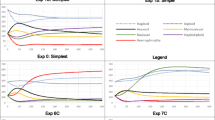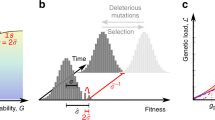Abstract.
We discovered a dynamic phase transition induced by sexual reproduction. The dynamics is a pure Darwinian rule applied to diploid bit-strings with both fundamental ingredients to drive Darwin's evolution: (1) random mutations and crossings which act in the sense of increasing the entropy (or diversity); and (2) selection which acts in the opposite sense by limiting the entropy explosion. Selection wins this competition if mutations performed at birth are few enough, and thus the wild genotype dominates the steady-state population. By slowly increasing the average number m of mutations, however, the population suddenly undergoes a mutational degradation precisely at a transition point mc. Above this point, the “bad” alleles (represented by 1-bits) spread over the genetic pool of the population, overcoming the selection pressure. Individuals become selectively alike, and evolution stops. Only below this point, m < mc, evolutionary life is possible. The finite-size-scaling behaviour of this transition is exhibited for large enough “chromosome” lengths L, through lengthy computer simulations. One important and surprising observation is the L-independence of the transition curves, for large L. They are also independent on the population size. Another is that mc is near unity, i.e. life cannot be stable with much more than one mutation per diploid genome, independent of the chromosome length, in agreement with reality. One possible consequence is that an eventual evolutionary jump towards larger L enabling the storage of more genetic information would demand an improved DNA copying machinery in order to keep the same total number of mutations per offspring.
Similar content being viewed by others
References
M. Eigen, Naturwissenschften 58, 465 (1971); M. Eigen, J. McCaskill, P. Schuster, Adv. Chem. Phys. 75, 149 (1989)
P.M.C. de Oliveira, J. Phys. C 19, 065147 (2007); also in www.arXiv.org Q-BIO.PE/0703020
D. Stauffer, S. Moss de Oliveira, P.M.C. de Oliveira, J.S. Sá Martins, Biology, Sociology, Geology by Computational Physicists (Elsevier, The Netherlands, 2006)
P.M.C. de Oliveira, J.S. Sá Martins, D. Stauffer, S. Moss de Oliveira, Phys. Rev. E 70, 051910 (2004); also in www.arXiv.org: cond-mat 0308617 and www.vjbio.org, Vol. 8, Issue 11
A.O. Sousa, S. Moss de Oliveira, A.T. Bernardes, Physica A 278, 563 (2000)
K. Bońkowsha, M. Kula, S. Cebrat, D. Stauffer, Int. J. Mod. Phys. C 18, 1329 (2007)
P.M.C. de Oliveira, www.arXiv.org: cond-mat 0101170, short version in Theory in Biosciences 120, 1 (2001); P.M.C. de Oliveira, Physica A 306, 351 (2002); also in www.arXiv.org: cond-mat 0108234
D. Stauffer, S. Cebrat, Adv. Compl. Syst. 9, 146 (2006)
M. Zawierta, P. Biecek, W. Waga, S. Cebrat, Theory in Biosciences 125, 123 (2007)
A. Pękalski, Int. J. Mod. Phys. C 18, 1690 (2007)
D. Alves, J.F. Fontanari, J. Physics A 30, 2601 (1997)
E. Tannenbaum, Phys. Rev. E 73, 061925 (2006); see also J.S. Wilkins, History and Phylosophy of the Life Sciences 28, 389 (2006)
J.-M. Park, M.W. Deem, Phys. Rev. Lett. 98, 058101 (2007)
K. Malarz, D. Tiggemann, Int. J. Mod. Phys. C 9, 481 (1998)
F. Bagnoli, M. Bezzi, Int. J. Mod. Phys. C 9, 999 (1998)
J.W. Drake, Proc. Natl. Acad. Sci. USA 88, 7160 (1991)
N.A. Moran, A. Mira, Genome Biology 2, 0054.1 (2001)
A.J. Fry, J.J. Wernegreen, Gene 355, 1 (2005)
F.M. Salzano, An. Acad. Bras. Ciênc. 77, 627 (2005)
Author information
Authors and Affiliations
Corresponding author
Rights and permissions
About this article
Cite this article
de Oliveira, P., Moss de Oliveira, S., Stauffer, D. et al. Does sex induce a phase transition?. Eur. Phys. J. B 63, 245–254 (2008). https://doi.org/10.1140/epjb/e2008-00229-3
Received:
Published:
Issue Date:
DOI: https://doi.org/10.1140/epjb/e2008-00229-3




